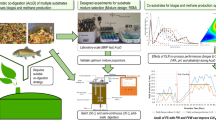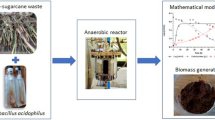Summary
The fate of a derivative ofEscherichia coli strain W3110G [pBGH1], a strain used for production of bovine somatotropin, was examined in semi-continuous activated sludge (SCAS) units. A nalidixic acid-resistant derivative of W3110G [pBGH1], strain LBB270 [pBGH1], was used to facilitate tracking. SCAS units (300 ml) containing municipal mixed liquor were operated on a daily cycle of 23 h aeration and 1 h settling followed by decanting of clear supernatant (175 ml) and refilling with fresh primary effluent. SCAS units were inoculated with two concentrations ofE. coli LBB270 [pBGH1] and operated for 200 h. Viable levels ofE. coli LBB270 [pBGH1] were measured daily in aerated mixed liquor and decanted supernatant. Viable counts in the mixed liquor decreased from 10000- to 100000-fold in less than 200 h. Losses ofE. coli LBB270 [pBGH1] in decanted supernatants accounted for less than 2-fold of the total losses observed in the SCAS units. TheE. coli LBB270 [pBGH1] was not evenly distributed in the mixed liquor, but became preferentially associated with the settleable floc. These results show thatE. coli LBB270 [pBGH1] was unable to survive in municipal sludge even when inoculated at concentrations greater than, or comparable to, levels of indigenous microorganisms.
Similar content being viewed by others
References
Bogosian, G., P.J.L. Morris, M.D. Hale and J.F. Kane. 1992. Fate in water of a recombinantEscherichia coli K-12 strain used in the commercial production of bovine somatotropin. J. Indust. Microbiol. 9: 27–36.
Bogosian, G. and J.F. Kane. 1991. Fate of recombinantEscherichia coli K-12 strains in the environment. Adv. Appl. Microbiol. 36: 87–131.
Box, G.E.P., W.G. Hunter and J.S. Hunter. 1978. In: Statistics for Experimenters. John Wiley & Sons, New York.
Calcott, P.H., J.F. Kane, G.G. Krivi and G. Bogosian. 1988. Parameters affecting production of bovine somatotropin inEscherichia coli fermentations. Dev. Indust. Microbiol. 29: 257–266
Fisher, R.A., H.G. Thornton and W.A. MacKenzie. 1922. The accuracy of the plating method of estimating the density of bacterial populations. Annu. Appl. Bacteriol. 9: 325–359.
Kane, J.F., S.M. Balaban and G. Bogosian. 1990. Commercial production of bovine somatotropin inEscherichia coli. In: Surface Reactive Peptides and Polymers: Discovery and Commercialization (C.S. Sikes and A.P. Wheeler, eds.), American Chemical Society Books, Washington, DC.
Kendal, M. and A. Stuart. 1979. The Advanced Theory of Statistics, Vol. 2: Inference and relationships. (4th. edn.) Macmillan, New York.
Koch, A.L. 1981. Growth measurement. In: Methodology for general bacteriology (Gerhardt, P., R.G.E. Murray, R.N. Costilow, E.W. Nester, W.A. Wood, N.R. Krieg and G.B. Philipps, eds.), pp. 179–207, American Society for Microbiology, Washington, DC.
Lennox, E.S. 1955. Transduction of linked genetic characters of the host by bacteriophage P1. Virology 1: 190–206.
Levy, S.B. 1984. Survival of plasmids inEscherichia coli. In: Genetic manipulation: impact on man and society (W. Arber, K. Illmensee, W.J. Peacock and P. Starlinger, eds.), pp. 19–28. ICSU Press, Paris.
Levy, S.B. and B. Marshall. 1979. Survival ofE. coli host-vector systems in the human intestinal tract. Recomb. DNA Tech. Bull. 4: 91–98.
Levy, S.B., B. Marshall and D. Rose-Eagle. 1980. Survival ofEscherichia coli host-vector systems in the mammalian intestine. Science 209: 391–394.
Smith, H.W. 1975. Survival of orally administeredE. coli K-12 in alimentary tract of man. Nature 255: 500–502.
Tukey, J.W. 1977. Exploratory data analysis. Addison Wesley, Reading, MA.
Vinopal, R.T. 1987. Selectable phenotypes. In:Escherichia coli andSalmonella typhimurium: cellular and molecular biology (Ingraham, J.L., K.B. Low, B. Magasanik, M. Schaechter and H.E. Umbarger, eds.), pp. 990–1015, American Society for Microbiology, Washington, DC.
Williams, P.H. 1977. Plasmid transfer in the human alimentary tract. FEMS Microbiol. Lett. 2: 91–95.
Author information
Authors and Affiliations
Rights and permissions
About this article
Cite this article
Heitkamp, M.A., Kane, J.F., Morris, P.J.L. et al. Fate in sewage of a recombinantEscherichia coli K-12 strain used in the commercial production of bovine somatotropin. Journal of Industrial Microbiology 11, 243–252 (1993). https://doi.org/10.1007/BF01569597
Issue Date:
DOI: https://doi.org/10.1007/BF01569597




